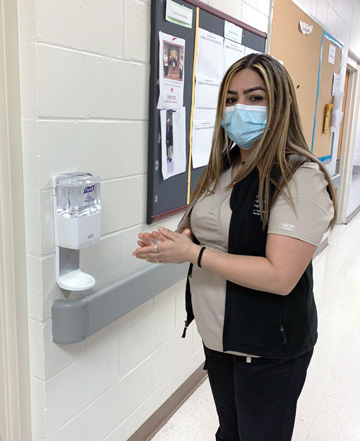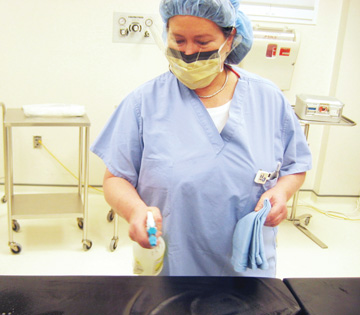Most surgical professionals are relatively knowledgeable about the best surface cleaning practices, and tried-and-true manual methods remain the best way to prevent the next patient from contracting an infection from the patient who was in the room before them. Yet there are still staff members who don’t keep cleaning agents on surfaces long enough for them to be effective or who usher turnover teams out of ORs to keep the schedule on track — even when the next patient hasn’t been adequately prepped for their procedure in the pre-op bay. These traits can put patients in danger and a facility’s accreditation status in peril.
- Home
- Article
Surface Disinfection Done Right
By: Frank Myers, MA, CIC, FAPIC
Published: 5/19/2022
Effective cleaning requires the proper tools, tactics and technologies — and a safety-first culture.
Disinfectant selection
Your first consideration should be contact time, because that’s what regulatory bodies are very concerned with and what you should consider when selecting a surface disinfectant. The disinfectants used must remain on surfaces for at least the amount of time the EPA says it takes to kill the organisms they’ve been tested against. From a practical perspective, the quicker the agent can do that, the better. The next consideration is material compatibility, which is crucial. I’ve seen many cases in which disinfectants with high alcohol contents have very quick kill times, but can cause cracking and chipping of plastic surfaces in the operating room. They can also cause glaze to form on touchscreen surfaces that are used more often in health care these days. Agents with a high alcohol content will cause touchscreens to become unreadable over time unless the screen is protected. Adding a plastic sheet over the screen will allow it to hold up better to contact with alcohols and quaternary ammonia disinfectants.
A lot of healthcare organizations, especially outpatient endoscopy centers, are concerned about Clostridiodes difficile (C. diff), bacteria that causes inflammation of the colon and other symptoms. It can be spread through contaminated surfaces. Many centers have turned to bleach-based products for surface disinfection, but these aren’t compatible with stainless steel. Bleach pits or corrodes stainless steel, so you’ll soon have an uncleanable and unusable surface. You can mitigate this problem by finding an agent that is more compatible with stainless steel or by removing stainless steel surfaces from your procedure areas.
A third consideration is knowing what organisms you want disinfectants to kill. Compare that list with the organisms those various disinfectants claim to kill. Not all manufacturers test their products against certain pathogens you’re looking to eradicate. Make sure the cleaning product you’re buying has been tested against the pathogens and claims to be able to kill them in a time that allows for acceptable room turnovers.
Perform a risk assessment to determine how important it is to achieve a sporicidal kill on all surfaces in your facility. Using C. diff as an example, refer to the CDC’s guideline for minimum expectations for infection prevention in outpatient settings as a starting point. Not all precautions necessary in a hospital setting are needed in an ASC in which patients are wheeled in and out of care areas in about 45 minutes. Furthermore, different outpatient settings call for different infection prevention protocols. A pain clinic, for example, doesn’t need to worry as much about C. diff, while an endoscopy center needs to take more precautions to kill it than a typical ASC.
Cleaning and confirming

When it comes to the sequence of cleaning an OR, work from the dirtiest areas of the room to the cleanest and pay particular attention to areas where bodily fluids spilled and where patients touched the most. AORN has comprehensive training programs
and toolkits on how to best clean ORs (osmag.net/Guideline). In general, you should clean rooms from the outside in and from top to bottom. Work either clockwise or counterclockwise the entire time to avoid cleaning the same area twice. You’re
basically spot cleaning until the end of the day, when a deeper terminal cleaning can take place.
Fluorescent markers are excellent training tools for your staff. The gel or powder can’t be seen under regular light. In a training
session, mark high-touch surfaces such as surgical lights, the side areas in the OR and the table on which you’re setting up your sterile field with the bioluminescent marking materials. Have your staff go in and clean the room. When
they’re done, enter the room with the lights off and use a black light or some other type of UV light to reveal which parts of the room were adequately cleaned and which weren’t. If the areas you marked don’t glow, you know
they’ve been thoroughly cleaned.
One of the best things about these products is that the staff members who clean ORs actually see the results, which makes it easier to understand what they missed. There’s something instructive about having simple, real, objective results in front of you that scream, “Hey, if there were bacteria on this surface instead of this fluorescent marker, the next patient would be exposed to infectious material.” Use of fluorescent markers can also help determine when to replace equipment. For example, the marks will remain in cracks or chips on a table you set up in the sterile field. When your staff tries to clean it again because the mark is still present, they’d realize it’s not cleanable because of the imperfection — and you’d know it’s time for a new table.
Adenosine triphosphate (ATP) testing is another way to check for gaps in your surface cleaning processes. It allows you to swab a small area after a surface clean and put the swab into a laminator machine, which tells you how much bacteria remain in the area. The potential problem with the teachability of using ATP testing is that it generates a reading based on relative light units (RLUs), which many frontline staff members view as a random number. RLU readings provide a probability of biofilm remaining on the surface and the threshold can be somewhat arbitrary. Plus, this technology doesn’t tell you the specific surface areas that staff missed during their cleaning, while fluorescent markers do.
Slow down for safety

The number one barrier to sound cleaning of OR surfaces between cases is time. I’ve done consulting work at a surgery center that used a disinfectant with clear instructions for use that said the product must stay on a surface for five minutes before being wiped off to get a germ kill. However, one of the center’s employees said the facility’s between-case turnover times were less than four minutes. Those kinds of situations aren’t safe for patients, aren’t likely to survive the scrutiny of a federal or state regulatory audit and, if the center was involved in litigation over a bad surgical outcome, would be very damning evidence about the surgery center’s priorities.
Obviously, this center could have switched to a disinfectant with a shorter required dwell time, but a fundamental change of culture is the better solution. In some cases, it just takes more time to safely prepare an OR for the next case than what you’re currently allocating to the task. I’ve also been in facilities that have rushed environmental services teams out of the OR because the next case allegedly had to begin right away. And yet, when the patient arrived, their hair had to be clipped because there wasn’t enough time to do it in the pre-op area.
It’s the responsibility of physicians and clinical leaders to ensure surface cleaning protocols contribute to reduced infection risks. These decisions may require adding a couple of additional steps to ensure patients move through their facilities safely and efficiently. OSM
.svg?sfvrsn=be606e78_3)
.svg?sfvrsn=56b2f850_5)